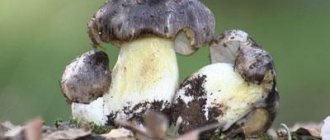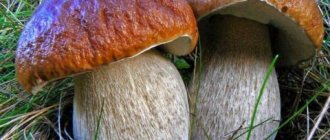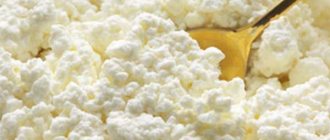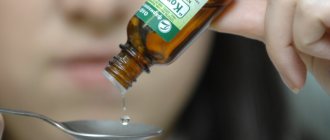Honey mushrooms are among the most popular types of mushrooms that autumn forests are so rich in, and are especially loved by mushroom pickers. These modest gifts of nature have a pleasant taste; they can be used for preparing first and second courses, baking, salting, frying, and pickling. But you should know that, contrary to the already established public opinion, the danger is posed not only by false honey mushrooms containing dangerous toxic substances, but also by completely edible species of these mushrooms.
Real honey mushrooms (pictured) are the most popular and beloved gifts of the autumn forest by mushroom pickers.
Intoxication of the body with substances that make up mushrooms is one of the most dangerous and can lead to death. How not to get poisoned by honey mushrooms, how to distinguish edible mushrooms from poisonous ones, what are the early signs of poisoning and what is the essence of treatment? Let's look at these and other questions in more detail.
How to distinguish false honey mushrooms from edible ones
Poisoning by false honey mushrooms can be caused by inattentive picking, during which the mushroom picker cannot accurately recognize the type of mushroom. Poisonous and edible mushrooms are very similar to each other, their places of growth often coincide, and the feature of growing on stumps in large groups is also copied.
Only inedible honey mushrooms have a so-called skirt, located under the cap. They differ in the color of the cap and the plates located on the inside. Poisonous mushrooms have a brighter and more saturated color. Edible honey mushrooms have a light brown cap with creamy plates located under it.
It is possible to distinguish mushrooms by texture only if there are old honey mushrooms, since young ones do not have this feature. Inedible species have scales in the central part of the cap.
A photo and description will help you recognize and distinguish between edible and false honey mushrooms. Poisoning by these mushrooms can be very dangerous for humans, and in some cases even leads to death.
Main causes of intoxication
In most cases, people are sure that in medical practice only poisoning by false honey mushrooms occurs. This opinion is incorrect. Edible mushrooms can also lead to intoxication if:
- collection took place near highways, chemical plants or simply in contaminated areas,
- even insect-infested specimens are collected,
- requirements for cooking mushrooms are ignored,
- storage standards have not been met or its shelf life has expired.
Honey fungus growing in polluted areas, no matter whether it is meadow or any other, quickly accumulates many toxic substances, such as cadmium, mercury, zinc, lead, cobalt. These mushrooms, in general, are capable of storing a huge amount of poisons without changing their external qualities and taste, which is why their consumption often leads to the development of intoxications.
Doctors recommend that women during pregnancy and breastfeeding, as well as young children, exclude mushrooms from their diet!
You can also be poisoned by pickled or salted honey mushrooms due to botulinum toxin if the mushrooms were poorly washed before cooking or the product’s expiration date has expired.
Types of false mushrooms
Before you determine what the signs and symptoms of false mushroom poisoning are, you need to know what types of these mushrooms exist. In particular, the following types are distinguished:
- sulfur-yellow honey fungus;
- brick-red poisonous honey fungus;
- false foam of Candol.
Sulfur-yellow honey fungus is most similar to edible honey mushrooms. To distinguish them from each other, a very careful examination is required. The cap of a poisonous mushroom has a brighter and more saturated color. It is often reddish or yellowish and smooth. The edible version has a light film between the stem and the cap, which is absent in the false honey fungus.
The brick-red poisonous honey fungus has a bright cap, as well as yellow plates located under it. Over time, they begin to change color to brown, dark or even greenish. It has an unpleasant odor and bitter taste.
Candol's false honey fungus has a very large and soft cap that easily breaks when touched. There is a white fringe along the edges of the cap. The bottom of the plates are black, with a grayish or purple tint.
How to avoid poisoning?
There are several ways to avoid such unpleasant consequences from mushroom dishes.
- You should only collect mushrooms in the forest that you are absolutely sure are safe;
- exclude collection near places that saturate mushrooms with heavy metals or toxic substances harmful to health;
- whether to buy mushrooms at the market or not is up to each person to decide for himself. Here, knowing the differences between false mushrooms and edible ones will, of course, help in choosing. But it is unlikely that the seller will want to tell where these mushrooms were collected;
- Follow the storage and cooking rules. Before cooking, mushrooms must be thoroughly washed. It is advisable to soak them for several hours, and in the case of canning, for several days, constantly changing the water;
- Mushrooms are stored in clay or aluminum containers.
Knowing these simple rules will allow you to enjoy the taste of delicious mushroom dishes without any harm to your health.
Causes of poisoning
You can be poisoned not only by poisonous honey mushrooms, but also by edible ones, since this mushroom tends to accumulate heavy metals. This is especially pronounced when they grow in environmentally unfavorable places. Similar conditions are created at a short distance from highways and roads with a large flow of cars. Significant emissions of toxic substances are typical for industrial areas and radioactive zones.
Toxic substances can be released during prolonged or improper storage of mushrooms. In this case, they become a favorable environment for the proliferation of pathogenic microorganisms. For the same reason, it is worth paying attention to the preliminary preparation of the product.
Can honey mushrooms have botulism?
Botulism in general is a severe toxic infectious pathology, which is characterized by systemic damage to the central nervous system. It is formed due to the active production of a specific botulinum toxin, which is produced by a spore-forming bacillus of the genus Clostridium.
Since the primary habitat of pathogenic bacteria is soil, all types of fungi can theoretically retain spores of pathogenic microflora both inside themselves and on the surface . A notable feature of botulism is that a potentially dangerous toxin is produced only under special conditions in the absence of air, the presence of fairly high humidity, and a temperature of about 35 degrees Celsius.
On freshly collected mushrooms, the pathogen indicated above is not present (there are only spores). However, if honey mushrooms are subsequently preserved without following all safety rules, then there is a possibility of contracting botulism.
Externally, it is almost impossible to identify pathogenic bacteria, and even more so a neurotoxin. Blistering of the lid with canned mushrooms and cloudiness of the liquid are characteristic features of other bacterial infections that are in no way related to the main dangerous pathology.
Symptoms
Many people are interested in how long it takes for symptoms to appear in case of false honey mushroom poisoning, so that the presence of a problem can be recognized in a timely manner. Often, the first signs appear 10-60 minutes after eating dishes that contain mushrooms. The symptoms of poisoning with false honey mushrooms are very acute. How long this happens depends largely on the amount of product, as well as the specifics of its preparation.
The primary signs include:
- attacks of nausea and vomiting;
- dizziness and headache;
- severe diarrhea;
- breathing problems;
- loss of consciousness;
- abdominal pain;
- chills, numbness of extremities.
Attacks of nausea and vomiting continue even after food particles are removed from the stomach with liquid, which can cause severe dehydration. A sign of poisoning by false honey mushrooms may also be that there is a lack of coordination, since it seems to a person that everything is revolving around him. Severe diarrhea can lead to dehydration.
It is worth noting that symptoms of poisoning with false mushrooms can be observed even if you eat a small amount of a poisonous mushroom. Substances may remain toxic after prolonged cooking, salting or frying.
Specifics
In the absence of appropriate knowledge, it is quite difficult to distinguish false honey mushrooms from real ones.
There is a widespread opinion among mushroom pickers, which is fundamentally erroneous, that only poisonous, so-called false honey mushrooms pose a danger to human life and health. Is it really not difficult for an experienced mushroom picker to distinguish edible varieties from poisonous ones and prevent possible negative consequences? Not at all, in reality everything is somewhat different.
The consumption of completely edible honey mushrooms, which grew in areas with poor ecology, or mushrooms prepared not in accordance with the rules prescribed by the instructions, can also lead to the onset of severe intoxication of the body with toxic substances. Other poisoning options are also possible. Before you begin collecting, preparing and subsequently consuming honey mushrooms, you should carefully familiarize yourself with the specifics of these activities and take the process seriously.
Advice! Regardless of the subsequent use of which mushrooms poisoning occurred, the patient must be examined by the attending physician. Self-medication carried out without medical supervision can cause serious consequences.
False honey mushrooms
After collecting or purchasing honey mushrooms, you should make sure that there are no poisonous mushrooms among the total mass.
One of the most common types of intoxication of the body with mushrooms is poisoning with false honey mushrooms. There are several types of poisonous mushrooms, the composition of which is rich in toxic substances that are potentially dangerous to humans. False honey fungus has a specific appearance, thanks to which it is quite easy to distinguish it from edible mushrooms; the video in this article will help you become more familiar with this issue.
Symptoms of poisoning with false mushrooms are varied and depend on the state of health and physiological characteristics of the victim’s body. In the vast majority of clinical cases, these include typical signs of food poisoning, but disruptions in heart rhythm, suffocation, and low blood pressure are also possible. Thus, to the question “is it possible to be poisoned by false honey mushrooms”, the categorical answer follows - yes, it is necessary to avoid eating these mushrooms.
Edible honey mushrooms
Some lovers of forest products are interested in this kind of question: is it possible to get poisoned by honey mushrooms, which are completely edible? Unfortunately, this form of food intoxication is quite possible.
As a rule, poisoning occurs if mushrooms that grow in a contaminated area or are not prepared in accordance with accepted rules are eaten:
- Mushrooms, like a kind of sponge, actively absorb almost all toxic substances, for example, mercury, heavy metals, and industrial waste. Accordingly, eating honey mushrooms growing in areas with unfavorable environmental conditions is potentially dangerous.
- You can be poisoned by honey mushrooms prepared in accordance with culinary processing violations. An insufficient amount of preservative components, long-term storage of salted or pickled mushrooms can lead to the formation of toxins in the product (see Is it possible to be poisoned by salted mushrooms: the consequences of improper preparation). Consumption of such dishes also poses a potential danger to human health.
Do not collect forest meat near highways or industrial sites
Accordingly, some caution should be taken when consuming edible mushrooms, especially if they were collected in close proximity to industrial production or their exact origin is unknown.
Advice! In order to minimize the risk of honey mushroom poisoning, it is recommended to eat only mushrooms that you have collected and prepared yourself.
You can be poisoned by both fresh and improperly prepared honey mushrooms.
Hepatotoxicity of false mushrooms
Symptoms of false honey mushroom poisoning resemble those of ordinary food poisoning. A negative factor is the rapid absorption of toxic substances into the blood and then distribution throughout the body. The biggest danger is that toxins cause liver damage, which cannot cope with toxic substances. As a result, the organ becomes enlarged.
Possible consequences
If caught in time, poisoning with false honey mushrooms can occur in a relatively mild form under the supervision of doctors. But if you underestimate the insidiousness of false mushrooms, it will end in hospitalization with intensive care for several days.
As a result, the influence of toxins will negatively affect work:
- kidney,
- of cardio-vascular system,
- nervous system,
- liver.
It will also lead to exhaustion of the body due to imbalance of water balance. In the worst case scenario, even death is possible.
Those at risk for whom intoxication has a particularly strong effect include:
- young children (up to 3 years old),
- elderly,
- people with a weakened body after an illness,
- pregnant women.
Recovery is especially difficult for those patients who suffer from chronic diseases related to the heart, kidneys or liver.
First aid for poisoning
Symptoms of poisoning with false honey mushrooms can be very different, which is why it is important to consult a doctor in a timely manner for a diagnosis. If a person shows signs of intoxication after consuming honey mushrooms, then it is important to take urgent measures. First aid is to cleanse the body of toxic substances. To do this, you need to do a gastric lavage and take activated charcoal.
When poisoned, the patient loses a lot of fluid and may die from dehydration, so the patient is provided with a lot of warm drink. To eliminate weakness, tremors and numbness of the limbs, a person should drink sweet, strong tea and apply a heating pad to his legs and arms.
Characteristic symptoms
Poisoning with false honey mushrooms often occurs due to the ingestion of a whitish liquid in the pulp, which is called “burning juice,” into the human stomach. After the pseudofungus enters the digestive system, signs of intoxication begin to appear within an hour. Less commonly, the process extends over a longer period (up to 6 hours).
The main symptoms of false foam poison entering the body are considered to be signs similar to ordinary food poisoning:
- a sharp deterioration in health,
- lethargy,
- nausea leading to periodic vomiting,
- diarrhea,
- pain in the abdomen and other unpleasant sensations.
Without medical intervention, such a feast can end with gastroenteritis or dehydration. That is why, at the first symptoms detected in yourself, it is necessary to urgently call an ambulance. Otherwise, the influence of the “burning juice” will begin destructive processes in the liver, the functionality of which will later have to be restored for a long time.
Complications after poisoning
If the victim receives qualified assistance in a timely manner, then within a few days all the signs will disappear. With more serious poisoning, when there is a high concentration of toxins in the liver and blood, the prognosis may not be reassuring enough. Severe poisoning can lead to complications such as:
- disruption of the functioning of internal organs;
- damage to the nervous system;
- deterioration of water-salt balance;
- death of the patient.
The most severe signs of poisoning are observed in the elderly and children under 3 years of age. A weakened immune system can lead to a rapid progression of the disease, which is why mushrooms should not be eaten by people of these age groups. The following factors significantly increase the risk of death from poisoning:
- pregnancy;
- weak immunity;
- rehabilitation period after serious illnesses;
- diseases of the liver, kidneys and heart.
It is important to promptly identify the first signs of the disease and consult a doctor. Correctly carried out medical measures will help eliminate the signs of poisoning without consequences for health.
General principles of treatment
Only timely first aid measures can prevent serious consequences.
Is it possible to be poisoned by pickled honey mushrooms that have been salted or undergone any type of heat treatment? And how does the chosen treatment depend on the type of food intoxication?
As mentioned above, despite the fact that the amount of mushrooms eaten, as well as the method of preparing them, have a direct impact on the symptoms and degree of poisoning, in general, characteristic signs appear even if a small portion is consumed. Conservative treatment of mushroom poisoning is selected in accordance with the clinical picture, the degree and form of poisoning, as well as such factors as the number of mushrooms eaten.
However, some procedures occur regardless of the aspects listed above, including:
|
|
|
| Lavage of the stomach and, if necessary, intestines. | Taking medications that cause vomiting. | Complete refusal of food during the first day after the appearance of early signs of poisoning. |
| Taking medications classified as enterosorbents, which is necessary to prevent the penetration of toxins into the blood. | The use of medications in the form of tablets, powders, injection solutions and injections that help remove toxins from the body. | Refusal of heavy, fatty, unhealthy and sweet foods. To restore the body and normalize the condition of internal organs, it is necessary to adhere to a gentle diet for at least two weeks. |
| Preventing dehydration and restoring water and salt balance by drinking plenty of fluids. | The use of medications that normalize and restore the condition of the systems and organs of the poisoned person. | During the treatment period, you should eat only light cereals and soups, fermented milk products, and lean meat. |
During the treatment process, one should not forget that failure to follow a balanced diet can lead to serious consequences, for example, disruption of the digestive tract.
Prevention
Prevention of poisoning from poisonous mushrooms is as follows:
- eat only familiar types of mushrooms;
- completely eliminate the use of wormy mushrooms;
- Carefully inspect each honey mushroom before cooking.
Carrying out preventive measures will help prevent poisoning and prevent deterioration of health.
If we talk about poisoning caused by food, mushroom poisoning is one of the most dangerous. Often, beginning mushroom pickers confuse edible mushrooms with inedible ones. This also applies to honey mushrooms, which are harmless mushrooms. With the onset of autumn, in the forest you can find not only honey mushrooms, but also their false doubles.
Edible and inedible
There are real and false honey mushrooms, the latter are dangerous to human health. There are differences between the first and second ones, by which one can distinguish a useful product from a harmful one.
| Name of part of the mushroom, characteristic feature | Edible | False |
| Film ring (main difference) | There is | only remains or missing |
| hat | covered with small scales | smooth |
| Plates under the cap | yellow | olive-black, greenish |
| Taste | sweetish | bitter |
| Leg | fleshy | thin |
There are several types of false honey mushrooms distinguished by color:
- Brick-red honey mushrooms. They have a cap up to 10 cm in diameter, reddish-orange in the center, and yellowish at the edges. The frequent internal plates near the stem are whitish, gray or dark olive along the edges. The pulp is yellow in color and smells unpleasant.
- Sulfur-yellow honey mushrooms. The thin-fleshy cap in the center is more intensely colored than at the edges, sometimes with an orange or reddish hue. The plates are gray-yellow in the center and greenish-olive at the edges. The pulp is hard.
- Seroplate honey mushrooms. They can be found on the trunks of coniferous trees. Some mushroom pickers consider this type of mushroom to be safe for health, although cases of poisoning with them are known. They are visually recognized by their frequent, thin plates, which are initially gray and then darken.
It should be remembered that symptoms of the disease appear after eating dishes not only from false mushrooms, but also from edible honey mushrooms, if they were collected near industrial enterprises, factories, highways or railroad tracks, or in other unfavorable areas. Then they accumulate harmful substances - lead, zinc, mercury, cadmium, copper, etc. Another common reason when you can be poisoned by honey mushrooms is improper cooking or violation of storage rules.
Symptoms of honey mushroom poisoning
After consuming honey mushrooms, symptoms of poisoning with false honey mushrooms will make themselves felt after two to three hours. At the initial stage, the signs of honey mushroom poisoning are similar to those that occur with any food poisoning. Namely:
- pain in the stomach and abdomen;
- rolling nausea;
- vomit;
- diarrhea;
- weakness.
Toxic substances that enter the body are instantly absorbed into the bloodstream. Then, with blood circulation, toxic compounds penetrate into all organs and systems of the body. There is a disruption in the functioning of cell membranes, followed by structural changes. As a result, all processes that occur in the body cease to function fully.
The digestive system reacts primarily to the penetration of poison inside. This is expressed in pressing pain in the abdominal area, turning into cramping pain. Nausea intensifies, vomiting attacks become more frequent. At this stage of honey mushroom poisoning, the risk of dehydration increases, which has its own consequences. If you do not provide first aid to the victim in case of honey mushroom poisoning in time, it will not be possible to avoid transportation to a medical facility.
Forecast
Fortunately, dishes prepared with these mushrooms do not pose a mortal danger. With proper treatment, a person recovers quickly - within a few days. Very often, improvement in well-being occurs within a few hours.
Deaths due to poisoning by honey mushrooms occur when there are complicating factors, namely:
- pregnancy;
- recent serious illness;
- ailments of the kidneys, liver, heart.
The most severe cases of mushroom poisoning are experienced by children and the elderly. The reason is water and electrolyte imbalance, which occurs as a result of acute gastroenteritis.
Subsequent manifestations of honey mushroom poisoning
After an hour or two, the victim’s symptoms will intensify. Signs of honey mushroom poisoning will appear, such as apathy, lethargy, weakness in the body, even trembling in the limbs. The nausea does not stop, and the attacks of vomiting become more frequent and profuse. Painful sensations that were previously localized in the stomach will spread throughout the entire peritoneum.
How does it affect the cardiovascular and central nervous systems?
After several hours have passed since the first signs of honey mushroom poisoning appeared, symptoms will appear that differ in nature from the symptoms of food poisoning. It is from them that they determine that the cause is mushrooms. Distinctive symptoms are expressed in disruption of the functioning of the central nervous system. Namely:
- worsening sleep leading to insomnia;
- human reactions become inhibited;
- dizzy;
- impotence;
- the appearance of hallucinations;
- consciousness becomes confused;
- slurred speech.
If one of the symptoms occurs, call an ambulance, or treat the victim yourself. This will reduce the risk of serious complications for the body.
If proper assistance is not provided, a person will gradually develop symptoms of dysfunction of the heart and blood vessels. This is explained by the fact that a toxin enters the human bloodstream, which is actively secreted by false mushrooms. It has a destructive effect on the cardiovascular system. Such symptoms are expressed as follows:
- blood pressure drops to critical levels;
- the skin acquires a bluish tint;
- heartbeat slows down;
- the pulse is difficult to palpate;
- arrhythmia appears;
- I feel very dizzy.
The danger of edible mushrooms
There are cases when people who consumed edible honey mushrooms sought medical help with acute intoxication. What is this connected with? Is it possible to be poisoned by honey mushrooms if there is absolute confidence that they are not poisonous?
Yes, there is such a possibility
. This is due to several reasons.
Firstly, if mushrooms were collected in places near industrial zones, roads or railways, there is a high risk that they have absorbed many harmful substances. Copper, mercury, lead and cobalt are an incomplete list of metals that contain such honey mushrooms.
Secondly, poisoning will be inevitable if harmful substances have accumulated in mushrooms as a result of improper storage or poor cooking.
The consequences of dangerous exposure can only be avoided if qualified medical care was provided on time.
What to do before medical workers arrive
In case of poisoning with false honey mushrooms, the toxins of the fungus quickly penetrate the bloodstream, the victim must be given first aid. It is aimed at removing from the stomach and intestines the remains of honey mushrooms that have not had time to be digested, thereby reducing their negative impact.
Timely assistance to elderly people, children and pregnant women is especially important:
- Perform gastric lavage. To do this, take one and a half liters of boiled water, cooled to room temperature. Divide the total amount of water into two doses. Drink in large sips. This will trigger vomiting.
- After the vomit ceases to contain food inclusions, give the victim a sorbent. Such drugs include enterosgel, smecta, activated carbon, polysorb, sorbex, atoxil and others.
- Next, you should maintain the water and electrolyte balance of the body. To do this, drink 100 ml of table or still mineral water every half hour. It is recommended to drink this liquid in small sips. This method will not cause the person to vomit again.
- If there is no diarrhea, give a laxative to drink. It will help remove toxic substances from the intestines.
- In case of elevated body temperature, which is accompanied by chills, cover the person with a warm blanket or warm them with a heating pad.
- If the stage of poisoning has progressed to one in which the person is unconscious, lay him down on his right side. At the same time, it is forbidden to leave it unattended, so that sudden vomiting does not cause choking on vomit.
- Provide the victim with bed rest and wait for the doctors to arrive.
Manifestation of intoxication
As a rule, poisoning with false honey mushrooms manifests itself almost immediately after eating them. However, in some cases, the body will respond within 6-12 hours.
Toxins that come to a person along with mushrooms almost instantly enter the bloodstream
. After this, they spread to all organs, poisoning them with toxic substances. The digestive system will suffer the most.
The symptoms of this type of intoxication are similar to acute gastroenteritis, and they are quite easy to recognize. They appear like this:
- nausea, which is accompanied by vomiting;
- pale skin;
- repeated loose stools;
- general weakness and malaise;
- severe abdominal pain.
If edible honey mushrooms poisoned by toxic compounds were eaten, the following signs are added to the described symptoms:
- severe attacks of headache and dizziness;
- bloating and discomfort in this area;
- sharp pain in the intestines;
- manifestation of dehydration due to intoxication.
As soon as the first signs of poisoning appear, you must urgently seek qualified help from a doctor. The sooner this is done, the less likely it is that toxins will enter the bloodstream and begin their destructive effect.
Important! If, soon after the first signs of poisoning appear, any disorders of the nervous system are added to them (strong desire to sleep, lethargy, hallucinations, or others), the person needs emergency medical help.
Without drug treatment, the signs of intoxication include depression of cardiac activity, expressed in decreased blood pressure and weak heartbeat, the skin turns blue, and the extremities become cold.
Despite the fact that cases of death from poisoning with these mushrooms are recorded quite rarely, the consequences of intoxication without proper treatment will be very dire.
How to distinguish false honey mushrooms from edible ones
To avoid poisoning by false honey mushrooms, you should remember their distinctive features. These include:
- The mushroom cap is small, about 6 cm in diameter, with watery inclusions and dark partitions under it. During the ripening process, it becomes covered with cracks;
- The leg of the false honey fungus is smooth and thin. You can find such mushrooms in the rotten bark of trees;
- the edges of the cap of the false honey fungus have a yellowish tint, and the middle is light red;
- there is no connecting film, which is located between the cap and the stem;
- the presence of yellowish pulp;
- earthy, musty smell;
- lack of a skirt on the leg;
- there are no scales on the top of the cap;
- The inedible honey fungus has a bitter taste. This will not change even if it is cooked for a long time, marinated or frozen.
To protect yourself from honey mushroom poisoning, you need to know the distinguishing features of bad mushrooms from good ones. Do not collect them near highways or enterprises. It is not recommended to purchase honey mushrooms from dubious sellers. And especially if the integrity of the stem and cap of such mushrooms is damaged.
Don't forget about the cooking rules. Honey mushrooms must be soaked for at least three days. At the same time, regularly changing the water in which they are located. The cooking process should last at least an hour. It is prohibited to store mushrooms in containers made of aluminum, clay and zinc. Compliance with the rules will eliminate poisoning and dangerous consequences for the body.
Preventive measures
To prevent poisoning from edible mushrooms, it is necessary to carefully select places for collecting mushrooms. Forests or fields are not suitable if there are:
- railways,
- highways,
- industrial enterprises.
It is also prohibited to collect mushrooms in large cities, where the concentration of exhaust gases, and therefore lead compounds, in the air is always high.
It is not recommended to buy mushrooms from strangers. Honey mushrooms are also not purchased if the integrity of their stem or cap is damaged, since it is in the mushroom debris that pieces of fly agarics or pale toadstools most often end up undetected.
When preparing honey mushrooms, you need to remember the basic rules. To avoid poisoning from salted mushrooms, they are soaked for at least three days, changing the water every three hours. Heat treatment of honey mushrooms should last at least 30 minutes. It is strictly forbidden to store mushrooms in dishes made of clay or aluminum, as well as in galvanized pans.
Have you ever had honey mushroom poisoning?
- Yes it was
- No, it was not
- There are symptoms now
- I don't eat mushrooms
ResultsPoll Options are limited because JavaScript is disabled in your browser.
- No, there were no 76%, 128 votes 128 votes 76% 128 votes - 76% of all votes
- Yes, there were 15%, 25 votes 25 votes 15% 25 votes - 15% of all votes
- Currently have symptoms 7%, 12 votes 12 votes 7% 12 votes - 7% of all votes
- I don't eat mushrooms 2%, 4 votes 4 votes 2% 4 votes - 2% of all votes
Total votes: 169 08/08/2017 You or from your IP have already voted. Vote
- Yes it was
- No, it was not
- There are symptoms now
- I don't eat mushrooms
You or from your IP have already voted. results
Poisoning with false honey mushrooms
False mushrooms are the name of certain types of mushrooms that are classified as poisonous. Visually, they have common features with natural honey mushrooms. Fake honey mushrooms belong to the Hyfoloma mushrooms of the Strophariaceae family. In addition, some of the representatives of Psatirel are poisonous mushrooms. Basically, fake mushrooms differ from ordinary mushrooms in that they do not have a ring on the stem.
Conditionally edible mushrooms
Honey mushrooms belong to the category of conditionally edible mushrooms, that is, those that under no circumstances should be eaten raw. Before eating conditionally edible mushrooms, they should be subjected to heat treatment. Moreover, it is necessary to cook honey mushrooms in two steps. First boil in one water, and then drain the broth and pour fresh water over the mushrooms. You need to cook honey mushrooms for at least half an hour. Otherwise, these mushrooms can cause poisoning.
However, even after appropriate treatment, honey mushrooms can cause diarrhea. In Austria, these mushrooms are even used as a natural laxative. That is why honey mushrooms should not be carried away by those who are prone to stomach upsets or suffer from other disorders of the gastrointestinal tract.
Regular abuse of honey mushrooms also negatively affects the pancreas and can lead to pancreatitis.
Honey mushrooms are contraindicated for preschool children, pregnant and lactating women, as well as people with a history of kidney disease, heart disease and hypertension.
How can you be poisoned by false honey mushrooms?
Everyone is accustomed to the fact that honey mushrooms are delicious mushrooms, most often used for pickling. But there are false plants that will cause serious health problems to the eater if they are consumed. Poisoning by them is conventionally divided into several stages: each of them is characterized by certain symptoms, which intensify as the toxins penetrate the body.
False honey mushrooms contain falla poisons and toxoids. Signs of impending pathology are expressed after toxins reach the human brain, often causing negative effects. Toxins affect the nervous system. And also on the work of individual organs and systems. In particular, the toxin from inedible plants affects the heart and brain. It depresses the heart, causing the pulse to become rare and blood pressure to drop. In difficult cases, the pressure drops to a critical value. As a result of a lack of oxygen in the body, a person’s skin and mucous membranes turn blue. A person feels drowsiness, pain in the head, and tinnitus. The stomach begins to instantly secrete juice and mucus, all of which causes diarrhea and vomiting. Gradual dehydration of the body occurs, and the blood begins to thicken. If a person is given help in time, the probability of death is quite high.
Prevention of poisoning
To avoid poisoning, successful lovers of “silent hunting” follow simple rules:
- they collect only mushrooms that are well known to them;
- do not stock up on mushrooms growing along highways or in industrial zones;
- Do not eat old, overgrown, wormy, slimy mushrooms.
You should not eat raw mushrooms. They must be boiled, but no later than 48 hours after collection. Before cooking, damaged areas and rot are cut off, crumpled and spoiled specimens are thrown away entirely.
Honey mushrooms with other mushrooms are contraindicated in acute diseases of the digestive organs, liver, kidneys, and in case of individual intolerance. There are also age restrictions: mushrooms can only be given to children over 9–10 years old, since this is too heavy a product for a child’s body.
Honey mushroom poisoning is intoxication caused by the presence of toxins in the product. They can cause acute gastroenteritis (inflammation of the stomach and small intestine); they cannot be eaten without special treatment.
Symptoms of poisoning
Stage 1:
- flatulence;
- stomach ache;
- heartburn;
- dizziness.
Stage 2 is characterized by an increase in intoxication of the body:
- lethargy;
- tremor of the hands and lower extremities;
- nausea;
- repeated vomiting;
- increased stomach pain;
- spread of pain to the abdomen;
- cold sweat;
- diarrhea;
- decrease in blood sugar levels.
First aid and treatment
The first thing the victim or his loved ones should do is call an ambulance.
After this, you need to perform procedures aimed at removing intoxication as quickly as possible:
- Cleanse the gastrointestinal tract. To do this, provoke a gag reflex by allowing the victim to drink at least a liter of boiled water. As soon as the vomit looks like ordinary water, the stomach can be considered empty. You can cleanse the stomach with vomiting only if it is not an independent symptom. In this case, it is enough to replenish the water balance in the body.
- After cleansing the stomach, activated charcoal is taken.
- Replenish your water balance by drinking a quarter glass of boiled or still mineral water every 10-15 minutes. Vegetable and chicken broths will provide invaluable help in this matter. At this time, any liquid should be drunk in small sips, slowly, so as not to provoke another attack of vomiting.
- If a person has lost consciousness, he must be placed on his side and his tongue secured so that it does not cause suffocation.
- If the victim feels chills, you should warm his hands and feet with heating pads.
- It is important to replenish your strength and get as much sleep as possible. At this time, you should not go outside, especially in the hot season, as liquid, which the body already lacks, will come out along with sweat.
Note! Taking any painkillers in case of poisoning is strictly prohibited! Since they will remove important signs of intoxication, and it will be difficult for doctors to prescribe the correct treatment. Moreover, they can cause a deterioration in the patient’s well-being.
Despite the importance of first aid, you should not overestimate your own knowledge in the medical industry: only a qualified physician can prescribe the correct treatment. Moreover, the specialist will inject the necessary drugs directly into the blood, which will quickly get rid of the poisoning. Correctly selected treatment also depends on age, gender, and type of heat treatment of mushrooms.
If treatment is carried out correctly and on time, the victim feels healthy within a few days.
First aid for poisoning
In case of poisoning, help is to prevent the spread of toxins, as well as to be able to avoid complications. The algorithm of actions in providing first aid is as follows:
- The stomach is cleansed. This is done in a hospital setting using a probe. If the ambulance has not yet reached the patient, then you need to drink more water in order to induce vomiting. To do this, you need to press on the root of the tongue with two fingers.
- If false honey mushrooms were eaten two hours later, it is worth doing a cleansing enema.
- Special medications and adsorbents are taken. Their benefit lies in the fact that these substances are able to absorb liquid with toxins dissolved in it. The drugs remove harmful substances from the body. Among the most used are activated carbon, Smecta, Enterosgel.
- Drink lightly salted water in small portions: this will help avoid dehydration. If Regidron is present in the medicine cabinet, then this drug is used.
- If vomiting stops, the patient should be given strong tea with sugar.
- A poisoned person should be wrapped up. If you have heating pads, you can use them too.
Honey mushrooms are one of the most desirable prey for mushroom pickers.
Honey mushrooms are one of the most delicious mushrooms, very popular among residents of Russia and other countries. Festive tables are often decorated with bowls of these creamy-brown mushrooms. They are fried and added to soups, salads and other traditional Russian dishes.
These wonderful mushrooms are sold frozen, and sometimes even fresh, in almost every supermarket today. However, their cost can scare off even the most ardent gourmet. On the one hand, it is justified, because the mushrooms were grown especially for you, collected, cleaned of contaminants, frozen and placed in neat packaging. However, as residents of the post-Soviet space say, saving should be economical, therefore, we proudly walk past refrigerated chests filled with mushrooms and go into the forest.
Mushroom picking is a traditional activity in our country and many others. However, seasonal visits to the forests always border on some danger, which consists in collecting inedible mushrooms.
Honey mushrooms are one of the most desirable prey for mushroom pickers. In the case of them, the danger increases several times, because, having aimed at collecting them, you can put in the basket not just an incomprehensible toadstool, which is simply thrown out when inspecting the prey at home. The fact is that honey mushrooms have, so to speak, twin brothers, called false honey mushrooms.
Each variety of mushroom has its own characteristics
Patient examination
To identify complications, make a correct diagnosis and select effective therapy, the doctor may need the results of additional laboratory and instrumental studies. Mushroom poisoning can cause disruption in the functioning of various organs and systems. Such complications must be identified and treated promptly.
An examination for honey mushroom poisoning is carried out in parallel with the provision of first aid and stabilization of the condition. It includes the following diagnostic techniques:
- a general detailed blood test helps to identify hemolysis, anemia, the presence of an acute inflammatory process in the body, and it can also be used to approximately assess the degree of dehydration;
- general urinalysis - necessary to assess the functional activity of the kidneys and to identify their damage. The kidneys are one of the first to be affected when eating poisonous mushrooms;
- biochemical blood test - necessary to identify electrolyte changes in the blood, disruption of the functioning of internal organs;
- electrocardiography (ECG) - needed to assess heart rhythm, which may be disrupted due to electrolyte shifts and dehydration;
- Ultrasound examination of internal organs is carried out to identify pathologies of the liver, gallbladder, pancreas and kidneys.
Please note that you do not need to immediately throw away a mushroom dish that has poisoned a person. It may be required for laboratory detection of toxins and poisons.
Features of medical treatment
The doctors who come to your call will conduct an examination and assess the patient’s condition. They will check his pulse, blood oxygen saturation (saturation), blood pressure level and breathing rate. Tell them in detail about the scope of pre-medical care you provided.
Before transporting the patient to the hospital, emergency physicians stabilize his condition.
If necessary, they can perform gastric lavage through a tube, connect the patient to an IV and oxygen, and administer antiemetics and painkillers.
Treatment for mushroom poisoning is carried out in intensive care or a toxicology hospital. Its duration depends on the severity of the patient's condition. For mild poisoning, they may be discharged on the third day.
Inpatient treatment consists of:
- therapeutic dietary nutrition;
- bed rest;
- intravenous administration of solutions to eliminate dehydration;
- hemodialysis - cleansing the blood of toxins using an artificial kidney, carried out in case of intoxication with false honey mushrooms;
- normalization of the cardiovascular system, kidneys, liver, pancreas.










